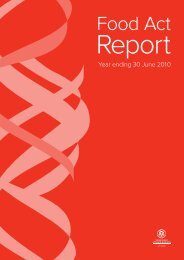Public Health and Communicable Diseases - SA Health - SA.Gov.au
Public Health and Communicable Diseases - SA Health - SA.Gov.au
Public Health and Communicable Diseases - SA Health - SA.Gov.au
You also want an ePaper? Increase the reach of your titles
YUMPU automatically turns print PDFs into web optimized ePapers that Google loves.
Australian hospitals, the optimum resource allocation forinfection prevention <strong>and</strong> control programs is uncertain<strong>and</strong> there has been very little information in the literaturespecific to Australian settings to guide such decisions.Historically, infection control programs have often beenviewed as expensive overheads with little appreciationof the potential of such programs to produce financialbenefits whilst simultaneously improving the outcomeof patient care. It is evident that more local researchneeds to be done in this area to guide the decisionmakers.References1. Wilson R, Runciman WB, Gibberd RW, HarrisonBT, Newby L, Hamilton JD. The quality in Australianhealth care study. The Medical Journal of Australia.1995;163:458-471.11. Scheckler W, Brimhall D, Buck A, et al. Requirementsfor infrastructure <strong>and</strong> essential activities of infectioncontrol <strong>and</strong> epidemiology in hospitals: a consensuspanel report. American Journal of Infection Control.1998;26:47-60.12. Saint S, Veenstra DL, Lipsky BA. The clinical <strong>and</strong>economic consequences of nosocomial centralvenous catheter-related infection: are antimicrobialcatheters useful? Infection Control <strong>and</strong> HospitalEpidemiology. 2000;21:375-380.13. Centers for Disease Control <strong>and</strong> Prevention.Guidelines for the Prevention of IntravascularCatheter-related infections. Morbidity <strong>and</strong> MortalityWeekly Report (MMWR). 2002;51:1-29.14. Haley RW. The scientific basis for using surveillance<strong>and</strong> risk factor data to reduce nosocomial infectionrates. Journal of Hospital Infection. 1995;30:3-14.2. Smith SD, Doebbeling BN. Costs of nosocomialinfections. Current Opinion in Infectious <strong>Diseases</strong>.1996;9:286-290.3. Centres for Disease Control <strong>and</strong> Prevention. <strong>Public</strong>health focus: surveillance, prevention <strong>and</strong> controlof nosocomial infections. Morbidity <strong>and</strong> MortalityWeekly Report. 1992;41:783-787.4. Kohn L, Corrigan J, Donaldson M. To err is human:buiding a safer health system. Washington, DC:Institute of Medicine; 1999.5. Plowman R, Graves N, Griffin M, et al. The Socioeconomicburden of hospital acquired infection.London: DoH/PHLS; 1999.6. Australian Infection Control Association ExpertWorking Group. National Surveillance of <strong>Health</strong>careAssociated Infections in Australia. A Report to theCommonwealth Department of <strong>Health</strong> <strong>and</strong> AgedCare; 2001.7. Davey P, Hernanz C, Lynch W, Malek M, Byrne D.Human <strong>and</strong> non-financial costs of hospital-acquiredinfection. Journal of Hospital Infection. 1991;18:79-84.8. Wenzel RP. The economics of nosocomial infections.Journal of Hospital Infection. 1995;31:79-87.9. Weinstein RA. Controlling antimicrobial resistancein hospitals: infection control <strong>and</strong> use of antibiotics.Emerging Infectious <strong>Diseases</strong>. 2001;7:188-192.10. Haley RW, Culver DH, White JW, Morgan WM, EmoriTG. The efficacy of infection surveillance <strong>and</strong> controlprograms in preventing nosocomial infections inUS hospitals. American Journal of Epidemiology.1985;121:182-205.36
















